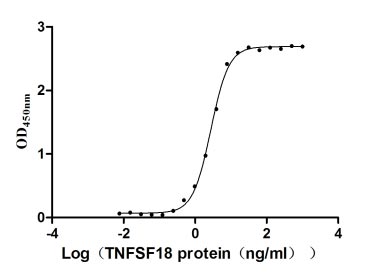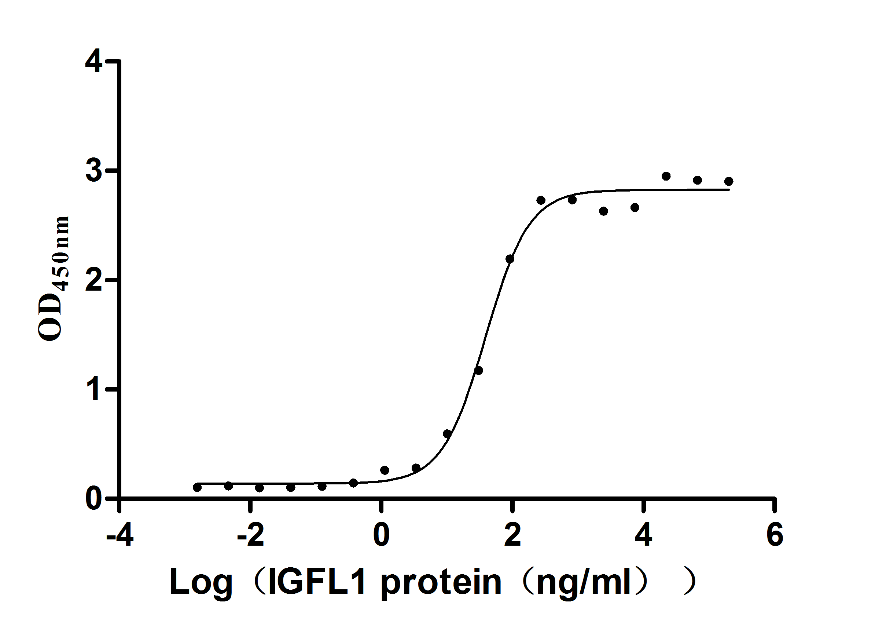Recombinant Mouse Nuclear receptor subfamily 1 group I member 3 (Nr1i3)
-
中文名称:小鼠Nr1i3重组蛋白
-
货号:CSB-YP016049MO
-
规格:
-
来源:Yeast
-
其他:
-
中文名称:小鼠Nr1i3重组蛋白
-
货号:CSB-EP016049MO
-
规格:
-
来源:E.coli
-
其他:
-
中文名称:小鼠Nr1i3重组蛋白
-
货号:CSB-EP016049MO-B
-
规格:
-
来源:E.coli
-
共轭:Avi-tag Biotinylated
E. coli biotin ligase (BirA) is highly specific in covalently attaching biotin to the 15 amino acid AviTag peptide. This recombinant protein was biotinylated in vivo by AviTag-BirA technology, which method is BriA catalyzes amide linkage between the biotin and the specific lysine of the AviTag.
-
其他:
-
中文名称:小鼠Nr1i3重组蛋白
-
货号:CSB-BP016049MO
-
规格:
-
来源:Baculovirus
-
其他:
-
中文名称:小鼠Nr1i3重组蛋白
-
货号:CSB-MP016049MO
-
规格:
-
来源:Mammalian cell
-
其他:
产品详情
-
纯度:>85% (SDS-PAGE)
-
基因名:Nr1i3
-
Uniprot No.:
-
别名:Nr1i3; Car; Nuclear receptor subfamily 1 group I member 3; Constitutive androstane receptor; CAR; Orphan nuclear receptor MB67
-
种属:Mus musculus (Mouse)
-
蛋白长度:Full length protein
-
表达区域:1-358
-
氨基酸序列MTAMLTLETM ASEEEYGPRN CVVCGDRATG YHFHALTCEG CKGFFRRTVS KTIGPICPFA GRCEVSKAQR RHCPACRLQK CLNVGMRKDM ILSAEALALR RARQAQRRAE KASLQLNQQQ KELVQILLGA HTRHVGPMFD QFVQFKPPAY LFMHHRPFQP RGPVLPLLTH FADINTFMVQ QIIKFTKDLP LFRSLTMEDQ ISLLKGAAVE ILHISLNTTF CLQTENFFCG PLCYKMEDAV HAGFQYEFLE SILHFHKNLK GLHLQEPEYV LMAATALFSP DRPGVTQREE IDQLQEEMAL ILNNHIMEQQ SRLQSRFLYA KLMGLLADLR SINNAYSYEL QRLEELSAMT PLLGEICS
-
蛋白标签:Tag type will be determined during the manufacturing process.
The tag type will be determined during production process. If you have specified tag type, please tell us and we will develop the specified tag preferentially. -
产品提供形式:Lyophilized powder
Note: We will preferentially ship the format that we have in stock, however, if you have any special requirement for the format, please remark your requirement when placing the order, we will prepare according to your demand. -
复溶:We recommend that this vial be briefly centrifuged prior to opening to bring the contents to the bottom. Please reconstitute protein in deionized sterile water to a concentration of 0.1-1.0 mg/mL.We recommend to add 5-50% of glycerol (final concentration) and aliquot for long-term storage at -20℃/-80℃. Our default final concentration of glycerol is 50%. Customers could use it as reference.
-
储存条件:Store at -20°C/-80°C upon receipt, aliquoting is necessary for mutiple use. Avoid repeated freeze-thaw cycles.
-
保质期:The shelf life is related to many factors, storage state, buffer ingredients, storage temperature and the stability of the protein itself.
Generally, the shelf life of liquid form is 6 months at -20°C/-80°C. The shelf life of lyophilized form is 12 months at -20°C/-80°C. -
货期:Delivery time may differ from different purchasing way or location, please kindly consult your local distributors for specific delivery time.Note: All of our proteins are default shipped with normal blue ice packs, if you request to ship with dry ice, please communicate with us in advance and extra fees will be charged.
-
注意事项:Repeated freezing and thawing is not recommended. Store working aliquots at 4°C for up to one week.
-
Datasheet :Please contact us to get it.
靶点详情
-
功能:Binds and transactivates the retinoic acid response elements that control expression of the retinoic acid receptor beta 2 and alcohol dehydrogenase 3 genes. Transactivates both the phenobarbital responsive element module of the human CYP2B6 gene and the CYP3A4 xenobiotic response element.
-
基因功能参考文献:
- Study uncovered a novel function of CAR in mediating the kidney-liver cross-talk in acute kidney injury (AKI). Renal IR downregulated the expression and activity of CAR and decreased the expression of microsomal triglyceride transfer protein (MTTP), which resulted in a decreased very-low-density lipoprotein triglyceride (VLDL-TG) secretion and lipid accumulation and liver injury. PMID: 29351922
- The role of the CAR signaling pathways within testis was validated using specific CAR agonist (TCPOBOP) and inverse agonist (androstanol) that respectively inhibited or reproduced the phenotype observed in Fxralpha-/- males fed Bile acids (BAs)-diet. These data open interesting perspectives to better define how BA homeostasis contributes to physiological or pathophysiological conditions via the modulation of CAR activity. PMID: 28181583
- data provide a comprehensive view of the CAR-regulated transcriptome and give insight into the mechanism of sex-biased susceptibility to CAR-dependent mouse liver tumorigenesis PMID: 28903501
- FXR signaling is a bile acid nuclear receptor that regulates lipids and glucose homeostasis and lack of it causes hepatomegaly and liver dysfunction. PMID: 29142166
- These results revealed the bilirubin transport regulatory mechanisms and highlighted the importance of CAR in modulating the bilirubin clearance pathway in the ALD mouse model. PMID: 28393244
- Activation of constitutive androstane receptor results in maintained biliary excretion of bile acids despite a marked decrease of bile acids in liver. PMID: 26984780
- CAR plays an important role in acifluorfen-induced liver injury and tumor development in mice. PMID: 26928356
- Activation of the nuclear receptor constitutive androstane receptor (CAR) induced FNDC5 mRNA expression in the liver. PMID: 27007446
- CAR is important for hepatic clearance of several widely prescribed drugs metabolized by P450 enzymes, however the fasting-induced alterations in P450-mediated drug clearance are largely independent of CAR. PMID: 27434302
- A functional network among CAR targeted genes and the affected microRNAs was constructed to illustrate how CAR modulation of microRNA expression may potentially mediate its biological role in mouse hepatocyte proliferation. PMID: 27080131
- The present study has revealed known and novel, as well as common and unique targets of PXR and CAR in mouse liver following pharmacological activation using their prototypical ligands. PMID: 27113289
- Results show that circadian disruption activates CAR via sympathetic dysfunction and cholestasis. The nuclear receptor CAR drives NAFLD to NASH, fibrosis, and hepatocellular carcinoma progression PMID: 27889186
- These data provide new insights into the regulation by CAR of glycolytic and lipogenic genes and on pathogenesis of steatosis PMID: 27180240
- CAR plays an important role in maintaining the homeostasis of cholesterol, bile acids, and triglycerides levels. PMID: 28283178
- CAR activation initiates a transcriptional program that facilitates the coordinated metabolic activities required for cell proliferation. PMID: 27530923
- This study demonstrated that Lack of CAR impacts neuronal function and cerebrovascular integrity in mice. PMID: 27240521
- CAR pathway was the main mechanism of liver tumor development induced by imazalil. PMID: 27853109
- data indicate that DE might be a potential therapeutic agent for obese pregnant patients with insulin resistance through CAR to prevent the perinatal outcomes such as preeclampsia, gestational diabetes, and macrosomia. Further analysis of possible complications and side effects using animal models is required. PMID: 27426490
- The negative regulation of PGC1alpha by CAR may represent a cellular adaptive mechanism to accommodate energy-restricted conditions. PMID: 26407237
- Data (including data from studies in knockout mice) suggest that CAR plays role in liver hypertrophy and hepatocarcinogenesis due to Ginkgo biloba extract used as dietary supplement in China; data are from subchronic toxicity tests. PMID: 26115596
- Combining CAR activation with limited beta-catenin activation induces tumorigenesis, and the tumours share a conserved gene expression signature with beta-catenin-positive human hepatocellular carcinoma. PMID: 25661872
- Constitutive androstane receptor is the main mediator of liver hypertrophy induced by cyproconazole and fluconazole, but not tebuconazole; constitutive androstane receptor played a crucial role in liver tumor development induced by all three triazoles. PMID: 25656644
- CAR activation decreases miR-122 levels through suppression of HNF4alpha transcriptional activity and indirectly regulates the promitogenic protein cMyc. PMID: 26171734
- The induction of CYP2B by PB or CFA was comparable to nuclear CAR levels. CAR nuclear translocation was induced by CFA in both rat strains. PMID: 25052003
- The nuclear receptor constitutive androstane receptor/NR1I3 enhances the profibrotic effects of transforming growth factor beta and contributes to the development of experimental dermal fibrosis. PMID: 25155144
- ubiquitin-proteasomal regulation of CCRP and HSP70 are important contributors to the regulation of cytoplasmic CAR levels, and hence the ability of CAR to respond to PB or PB-like inducers PMID: 24789201
- Data indicate that in the CAR nuclear receptor (CAR)-deficient mice, fatty liver was observed not only in the ethanol group but also with the ethanol plus polyphenol groups. PMID: 24498295
- These results suggest that in vivo deletion of CAR resulted in higher bone mass, which appears to be a result from reduced metabolism of testosterone due to down-regulation of Cyp2b. PMID: 24114688
- Studies indicate that phenobarbital binding to EGFR inhibits distal signaling to derepress RACK1-facilitated dephosphorylation of constitutive active androstane receptor (CAR) by PP2A, and activates the transcription of Cyp2B10. PMID: 23652202
- Data indicate that the phosphorylation status of constitutive active androstane receptor (CAR) and EGFR in response to phenobarbital and EGF was confirmed in hepatocytes. PMID: 23652203
- Xenobiotic-induced hepatocyte proliferation mediated by CAR or PPARalpha is enhanced by PXR co-activation despite the fact that PXR activation alone does not cause the cell proliferation in mouse livers. PMID: 23626729
- The constitutive androstane receptor is involved by a dose-response relationship in mouse liver hypertrophy induced by triazole fungicides. PMID: 23721867
- Neonatal activation of CAR results in epigenetic memory and a permanent change of liver drug metabolism. PMID: 22488010
- AhR, CAR, PXR, PPARalpha, and Nrf2 regulate genes encoding drug-metabolizing enzymes and transporters in livers of mice after chemical activation. PMID: 22496397
- phenobarbital-mediated down-regulation of miR-122 is an early and important event in the AMPK-dependent CAR activation and transactivation of its target genes PMID: 22815988
- CAR mRNA expression was increased by hypothyroidism PMID: 22503787
- CAR and PXR are closely associated and have diverse roles, both as positive and negative regulators of hepatic genes. PMID: 22698814
- SRC-3 is the predominant transcriptional co-activator among the three SRC family members for CAR activation to promote hepatocyte proliferation and drug metabolism. PMID: 21827731
- Nuclear receptor CAR (NR1I3) is essential for DDC-induced liver injury and oval cell proliferation in mouse liver. PMID: 21826054
- Hepatocyte-specific knockout of beta-catenin inhibited CAR agonists-induced hepatocyte proliferation in male mice. PMID: 21705713
- activated ERK1/2 interacts with CAR and represses dephosphorylation of Thr-38, providing a cell signal-regulated mechanism for CAR activation. PMID: 21873423
- CAR is involved in the control of cholesterol and bile acid homeostasis, increasing reverse cholesterol transport under hyperlipidemic conditions. PMID: 21145854
- Constitutive androstane receptor activation decreases plasma apolipoprotein B-containing lipoproteins and atherosclerosis in low-density lipoprotein receptor-deficient mice. PMID: 21778422
- role in modulating alcoholic liver injury PMID: 21519326
- FAM84A is up-regulated by CAR during the development of liver tumors. PMID: 21424122
- deletion of CAR leads to a significantly lower tumor incidence and smaller tumor diameter PMID: 21173431
- CAR may repress death of mouse primary hepatocytes by forming a GADD45B complex and repressing MKK7-mediated phosphorylation of JNK1 PMID: 20404936
- FXR activation in obstructive cholestasis might worsen liver injury by hijacking a protective mechanism regulated by CAR and provides a new molecular explanation to the pathophysiology of cholestasis. PMID: 21296199
- Helix 11 dynamics is critical for constitutive androstane receptor activity. PMID: 21220114
- Data observed that OSM positively augmented the CAR and UGT1A1 expressions and CAR-mediated signaling in vivo and in vitro, through cross talk between the nuclear CAR receptor and the plasma membrane OSM receptor, via the MAPK cascade. PMID: 20197307
显示更多
收起更多
-
亚细胞定位:Nucleus. Cytoplasm. Cytoplasm, cytoskeleton. Note=Recruited to the cytoplasm by DNAJC7.
-
蛋白家族:Nuclear hormone receptor family, NR1 subfamily
-
组织特异性:Predominantly expressed in liver.
-
数据库链接:
KEGG: mmu:12355
STRING: 10090.ENSMUSP00000005820
UniGene: Mm.486506
Most popular with customers
-
Recombinant Human Tumor necrosis factor ligand superfamily member 18 (TNFSF18), partial (Active)
Express system: Mammalian cell
Species: Homo sapiens (Human)
-
Recombinant Human IGF-like family receptor 1 (IGFLR1), partial (Active)
Express system: Mammalian cell
Species: Homo sapiens (Human)
-
Recombinant Human G-protein coupled receptor family C group 5 member D (GPRC5D)-VLPs (Active)
Express system: Mammalian cell
Species: Homo sapiens (Human)
-
Recombinant Macaca mulatta Semaphorin-4D isoform 1 (SEMA4D), partial (Active)
Express system: Mammalian cell
Species: Macaca mulatta (Rhesus macaque)
-
Recombinant Mouse Tyrosine-protein kinase Mer (Mertk), partial (Active)
Express system: Mammalian cell
Species: Mus musculus (Mouse)
-
Recombinant Human Claudin-9 (CLDN9)-VLPs (Active)
Express system: Mammalian cell
Species: Homo sapiens (Human)
-
Recombinant Human Myosin regulatory light chain 12B(MYL12B) (Active)
Express system: E.coli
Species: Homo sapiens (Human)
-
Recombinant Human Dipeptidase 3(DPEP3), partial (Active)
Express system: Mammalian cell
Species: Homo sapiens (Human)




















